Microwave packaging: Making micro gains

Recently, I was talking to a longtime packaging guy about microwave packaging and asked him if he thought the segment today is where, five years ago, he believed it would be.
“No. I thought there would be faster adopters,” he said, quickly pointing out he does not fault consumers. He is convinced that processors are still skeptical about shoppers’ willingness to pay for quality, microwaveable food despite a preponderance of consumer research to the contrary.
Perhaps their subdued response represents a natural reluctance to change or maybe, in what many still see as a fragile economy, it is an unwillingness to spend money on something regarded as not broken. Depending on the desired production volumes, shelling out what could be several millions of dollars to retrofit packaging lines for a new format carries significant risk. To reach escape velocity, processors must see microwave packaging translating to dollars in their pockets.
If we step back a bit and look at the bigger picture, we see consumer dynamics that have driven microwave packaging are the same as they were five or even 10 years ago. We are all time-starved and, for the most part, do not know at 5 o’clock what we are having for dinner. But, whatever we do eat, we want it to taste great, be convenient to prepare and deliver value. The opportunities are there. According to an industry source, meal entrees that scream “good for you” and imply trust, such as organic, all-natural, locally grown and fresh, are where the growth is.
The packaging is more rigid format than flexible. Rigid is easier and more convenient for consumers to handle, and it just feels more substantial, which is another checkmark in the value column. Shoppers also are responding favorably to transparency. Clear trays are a hit because the food is visible — people want to see what they are paying for. The packages are either tray-skin or tray-lid. Tray-lid is more common because so many processors already have tray-lid equipment in place, but the traditional tray look needs to go. Consumers react positively to re-shaped trays that look like plates. When we take a delicious meal from the microwave, we prefer eating it from a plate, not a rectangle. Research shows people will pay for good quality and perceived value. A paradigm shift is occurring. Instead of burgers and fries, consumers see more retail options of high-quality refrigerated entrees in the $7 to $10 range. That does not seem to be a big stretch in price for what is a dramatic leap in value and quality.
Microwave packaging is also driving food as an ingredient. Additions such as chicken strips and ground beef crumbles are gracing everything from salads to pizzas at the dinner table.
Today, real impact is coming from new, smaller players entering the marketplace with business models that fit present conditions. They have decided to place quality production over volume production because it is so hard to be successful doing both. Consequently, they are growing and grabbing market share. The food market is so large, there is plenty of room for all types of cooking, from the oven to scratch. But since microwaves use only 10 percent of the energy of a traditional oven, they are not going anywhere. Microwave packaging seems like a good bet. NP
Looking for a reprint of this article?
From high-res PDFs to custom plaques, order your copy today!









